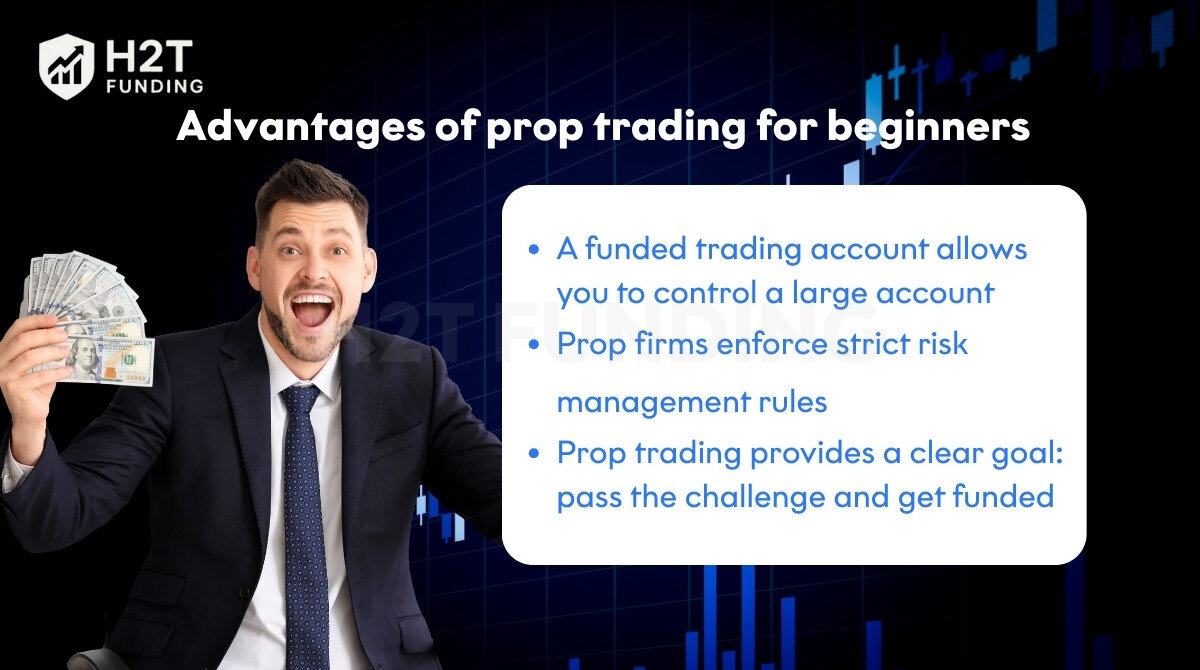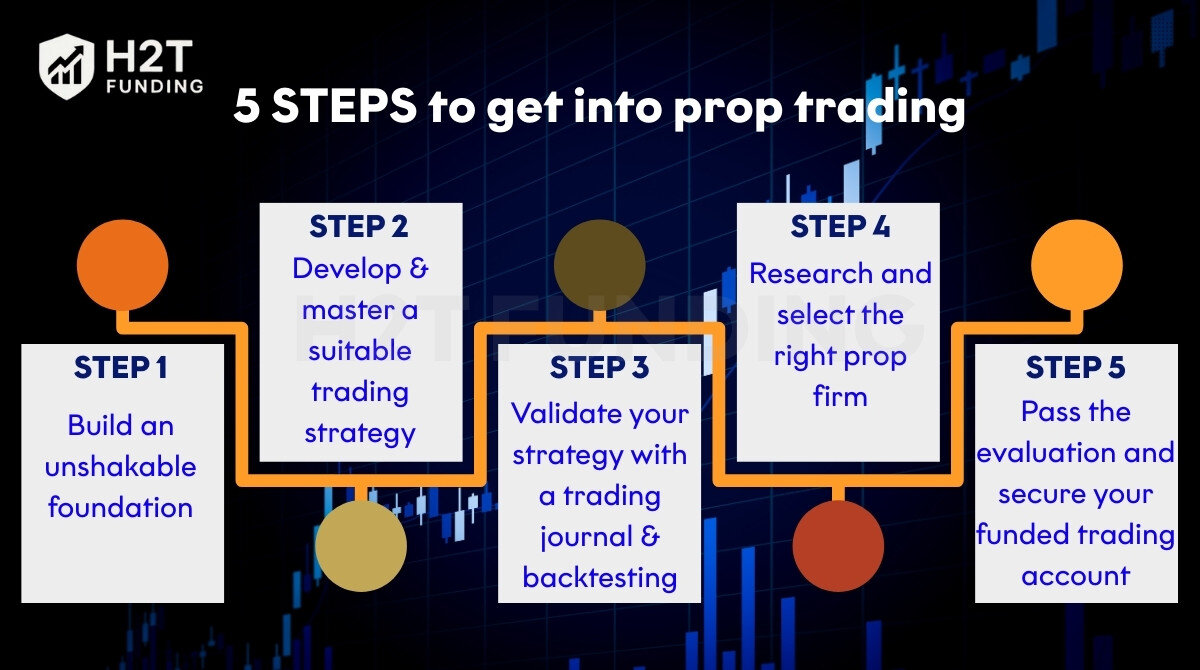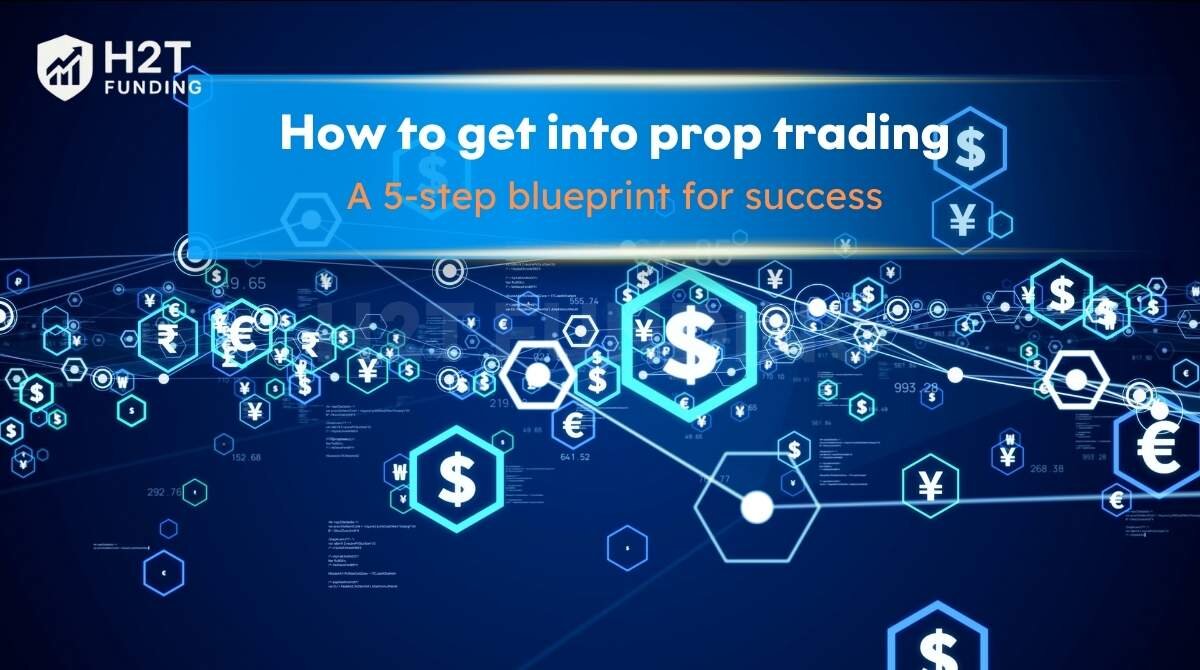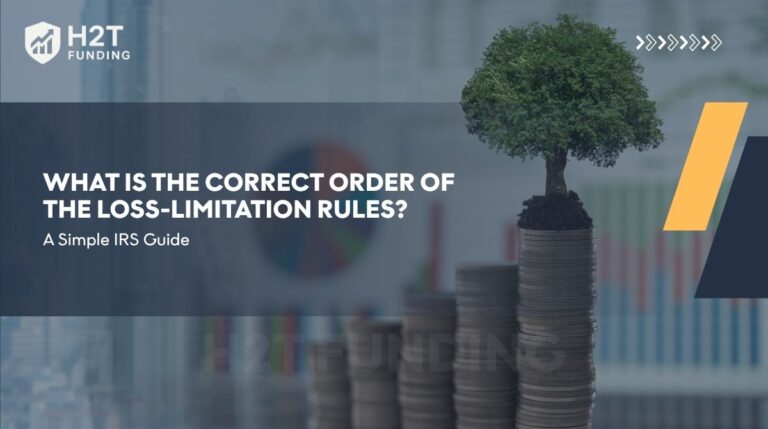The world of online proprietary trading has unlocked a powerful career path for traders worldwide. It offers a unique opportunity to trade a firm’s capital, giving you the leverage to earn significant profits without risking your personal savings.
To begin, it’s essential to understand the advantages of proprietary trading. This modern approach is vastly more accessible than the traditional, high-barrier route of Wall Street.
However, accessibility does not mean it’s easy. Success requires a specific blend of skill, strategy, and psychological fortitude. This guide offers a realistic, step-by-step blueprint on how to get into prop trading successfully. We’ll go beyond the basics, exploring the “why” behind the rules and the mindset needed to thrive long-term.
Ready to dive deeper into how H2T Funding can help you navigate this exciting path? Continue reading our comprehensive guide to master the art of prop trading.
Key Takeaways:
- Understand prop trading: It’s using a firm’s capital for profit, offering a more accessible path than traditional finance.
- Prop trading benefits beginners: It removes capital barriers, enforces discipline, and provides a clear career growth path.
- Preparation is key: Success demands a tested strategy, strong psychological resilience, and strict adherence to firm rules.
- Follow the 5-step blueprint: Build foundational skills, master a suitable strategy, validate with journaling/backtesting, select the right firm, and trade the evaluation like a live account.
- Be aware of pitfalls: Guard against unreliable firms by checking rules, transparency, support, and payout reputation.
1. What exactly is prop trading?
What is a prop trading firm? In short, it’s a company that uses its own capital to trade financial markets. They provide this capital to skilled traders, who then execute trades based on their strategies. In exchange for this arrangement, any profits are divided between the trader and the firm through a ‘profit split’ agreement.
A prop trading firm is a company that uses its own capital to trade financial markets

1.1. The traditional path: Wall Street banks & hedge funds
Historically, prop trading was the domain of elite investment banks and hedge funds. This path demands a top-tier university degree, extensive industry experience, and the willingness to work in a grueling, high-pressure office environment. It remains a very exclusive club.
1.2. The modern path: Online prop trading firms
The new era is defined by online and remote prop trading firms. These companies have democratized access to capital, offering a funded trader program to anyone who can prove their ability through an evaluation. You trade their capital from home and keep a high percentage of the profits.
2. Why prop trading can be ideal for beginners?
For many aspiring traders struggling to get started, the prop firm model offers a structured and accelerated path. From my personal vantage point in this industry, I truly believe it’s one of the most accessible and effective ways for ambitious beginners to break into serious trading.

The reason why prop trading is ideal for beginners
Here are the core advantages that make it so appealing:
- The capital barrier is removed:
- The single biggest hurdle for a new trader is a lack of capital. A funded trading account allows you to control a large account (e.g., $100,000) for the small cost of an evaluation fee, a sum far less than the capital itself.
- From my perspective, this is a game-changer; it democratizes access to serious capital, which historically was only available to a select few with deep pockets.
- Forced discipline and structured risk:
- Many new traders fail because they lack discipline. Prop firms enforce strict risk management rules. This framework forces you to develop good habits that are essential for long-term survival in the markets.
- I’ve seen countless traders benefit from this structured environment; it’s like a high-performance training ground that builds the very habits most solo traders struggle to cultivate.
- A defined career path:
- Prop trading provides a clear goal: pass the challenge and get funded. Most firms also offer a scaling plan, allowing you to manage more capital as you prove your consistency. This creates a clear path for professional growth.
- This aspect truly makes it feel like a legitimate career trajectory, rather than just a hobby, offering tangible milestones for progress.
3. Key considerations before embarking on a prop trading career
Before you pay your first evaluation fee, it’s crucial to perform an honest self-assessment. This is not a path to get rich quickly, and success depends on being thoroughly prepared.
3.1. Your trading skills and strategy
Is your trading strategy built upon a distinct and well-defined advantage? Have you tested it, refined it, and proven its profitability in a demo environment over a significant period? Jumping into a challenge without a validated plan is the fastest way to fail.
I’ve personally witnessed countless individuals rush into challenges, only to find that the lack of a tested strategy was a critical flaw. The basic prop trader requirements always start with having a workable strategy.
You can learn more about creating a robust and disciplined trading approach by understanding what is a trading plan. This will help you build the structure and discipline essential for long-term success.
3.2. The psychological requirements
Are you resilient? Are you capable of enduring a series of losses while remaining committed to your trading plan? Trading success is a mental game. You need patience to wait for the right setups and discipline to execute your strategy flawlessly, even when you’re feeling fearful or greedy.
3.3. Understanding the firm’s rules
Are you prepared to operate within a strict framework? To succeed, you must understand the logic behind the rules and be willing to adhere to them completely. This includes:
- The drawdown limits: This is the firm’s primary way to protect its capital.
- The profit target: This validates that your strategy can actually generate returns.
- Specific restrictions: This could mean rules against holding trades over the weekend or during major news events.
Read more:
4. Who is best suited for proprietary trading?
Proprietary trading isn’t for everyone; it demands a specific blend of traits and commitment. Individuals who thrive in this environment are typically disciplined, patient, and highly resilient. They possess a strong analytical mind and a genuine enjoyment for problem-solving and strategic thinking.
Critically, successful prop traders have excellent emotional control, allowing them to stick to their plan even after losses or during periods of high market volatility. A dedication to continuous learning and a realistic understanding that trading is a marathon, not a sprint, are also essential.
5. How to get into prop trading: The 5-step blueprint to getting funded
This is the core of your journey. This blueprint demystifies the entire evaluation process and shows you how to get into prop trading firm. To enhance your probability of success, it is crucial to methodically follow this established procedure.

5.1. Step 1: Build an unshakable foundation
Before you even think about an evaluation, you must master the fundamentals. This goes beyond chart patterns. Focus on understanding market structure, price action, and, most critically, the principles of risk management. This is the most crucial of all trading skills.
5.2. Step 2: Develop & master a suitable trading strategy
Your trading strategy is your business plan. It must be specific, repeatable, and tested. However, not all strategies are well-suited for the prop firm challenge environment.
Compare 3 trading strategies: day trading, swing trading, and scalping.

- Which strategy works best?
- Day trading is often the most suitable. The shorter feedback loop allows you to work towards the profit target and easily adhere to “no overnight hold” rules. If you’re looking for strategies that are well-suited for new traders and can help you make reasonable choices when starting out, explore the best trading strategy for beginners.
- Swing trading can work, but it’s more challenging. It requires a calm temperament not to force trades under a time limit.
- Scalping is generally not recommended for challenges. Commissions and spreads can eat away at small profits, and the high frequency can easily lead to over-trading.
- Example in practice: Imagine your day trading strategy is a mean reversion system on the 15-minute chart. You must define every variable: What indicators signal an entry? What is the exact entry trigger? Where is the stop-loss placed? How do you determine your profit target or the signal to exit a trade?
5.3. Step 3: Validate your strategy with a trading journal & backtesting
This is the step most aspiring traders skip, and it’s why they fail when trying to figure out how to get into a prop trading firm. You must prove to yourself that your strategy works before trying to prove it to a prop firm.
- Use a trading journal: A journal like Tradervue or a simple spreadsheet is not optional. It’s your single most important tool for improvement.
- Backtest your system: Use tools like TradingView’s Bar Replay to manually backtest your strategy. This builds unshakable confidence in your system.
5.4. Step 4: Research and select the right prop firm
With a validated strategy, you are now ready to choose a partner. Your goal is to find a reputable firm with rules that align with your trading style, especially if you are looking for prop trading firms for beginners. This selection isn’t just about picking the biggest name; it’s about finding the firm that truly complements your specific approach to the market.
From my experience, many aspiring traders jump into the first firm they see, only to realize later that the rules or culture clash with their natural trading rhythm. Taking the time here can save you immense frustration and potential financial loss down the line.
Key factors to compare:
- Evaluation criteria:
- This is where the rubber meets the road. Assess whether the profit goals and drawdown restrictions are genuinely achievable with your strategy. Are daily drawdown limits reasonable for your typical trading volatility? Are the profit targets aggressive or more conservative?
- I always advise looking for clarity here. Hidden consistency rules or vague drawdown calculations can be deadly traps. For instance, comparing firms like Topstep can give you a real-world perspective on how different evaluation models operate.
- Profit split:
- A split of 80% or higher is quickly becoming the industry standard. While some firms might offer slightly less, ensure it’s a fair reflection of the risk they’re taking and the value they provide.
- Don’t be swayed by offers that seem too good to be true (e.g., 95% from day one) without thoroughly checking their reputation and payout history.
- Scaling plan:
- How does the firm reward consistency? A good scaling plan shows they are invested in your long-term growth, not just collecting evaluation fees.
- Look for clear milestones and automatic account increases as you prove your profitability. This signals a true partnership, where your success directly translates to theirs, and it’s a huge motivator for traders.
- Reputation & payouts:
- This is perhaps the most critical factor. Search for independent reviews focused specifically on payout proof and customer service. Unfortunately, I’ve witnessed firms with great marketing but terrible payout track records. Always prioritize firms with a consistent history of prompt and transparent payments.
- Look for discussions in reputable trading communities and third-party review sites. Additionally, if you’re a beginner, researching the easiest prop firms to pass can offer a good starting point, but remember, “easiest” still requires solid discipline and adherence to the firm’s specific rules.
5.5. Step 5: Pass the evaluation and secure your funded trading account
Now, it’s time to perform. The key to passing an evaluation is to trade it like it’s already a funded trading account. Shift your focus away from the profit target and any time constraints. Focus exclusively on executing your tested strategy and respecting the drawdown rules on every single trade.
Consistency, not speed, is what gets you funded.
6. The psychological battle: What to expect at each stage
Getting funded is as much a mental game as it is a strategic one. Being prepared for the psychological shifts during the trading challenge is critical.
- During the challenge phase, you will feel the pressure of the clock and the profit target. After a loss, the urge for “revenge trading” will be strong. You must fight this by reminding yourself to trust the process.
- During the funded phase, A new fear emerges: the fear of losing the account. This can cause you to become overly hesitant. The antidote is the same: trust your system.
7. Red flags: How to spot an unreliable prop firm
As the industry grows, so does the number of untrustworthy players. Protect yourself by looking for these warning signs:
Pay attention to the 3 red flags of an unreliable prop firm
- Unrealistic rules: An extremely high profit target combined with a tiny drawdown limit.
- Vague or hidden information: The firm should be transparent about its commission, spreads, and broker.
- Poor customer support: If you can’t get a clear, professional answer before you sign up, run away.
- Consistent negative reviews about payouts: This is the biggest red flag of all.
8. Prop trading vs. Traditional CFD trading: Which path is right for you?
For aspiring traders, the financial landscape offers several avenues. Two common paths you’ll encounter are proprietary trading (prop trading) and traditional CFD trading through a retail broker.
While both involve speculating on market movements, their fundamental structures, risks, and opportunities for a trader are vastly different. Understanding these distinctions is crucial for choosing the right route for your trading journey.
8.1. Traditional CFD trading: The self-funded route
In traditional CFD (Contract for Difference) trading, you open an account with a retail broker and trade with your own capital. The broker acts as an intermediary, providing you access to the markets. All profits are yours, but so are all the losses, directly impacting your personal funds.
- Your capital, your risk: You’re putting your own money on the line. If you blow the account, that capital is gone.
- Direct broker relationship: You deal directly with a regulated broker, who facilitates your trades.
- Unlimited downside potential: While leverage offers amplification, it also means your losses can quickly exceed your initial deposit if not managed meticulously.
8.2. Prop trading: Leveraging firm capital
Proprietary trading, especially the modern evaluation-based model, flips this dynamic. Instead of using your own substantial capital, you participate in an evaluation or challenge. If successful, you gain access to the firm’s capital for trading, sharing a percentage of the profits you generate.
- Firm’s capital, shared risk: You trade with the firm’s money. While you must adhere to strict risk rules, your personal downside is limited to the evaluation fee. This, to me, is the single biggest game-changer for aspiring professionals; it removes the paralyzing fear of losing your life savings.
- Structured environment: Firms enforce strict drawdown and risk rules. I’ve seen firsthand how this forced discipline transforms amateur traders into consistent ones, instilling habits rarely learned in traditional trading without significant losses.
- Clear growth path: Prop firms often offer clear scaling plans, allowing you to manage more capital as you consistently prove your profitability. This provides a tangible career progression.
8.3. Prop trading vs. Traditional CFD trading: A quick comparison
| Feature | Traditional CFD Trading | Modern Prop Trading (Evaluation-based) | My Take |
|---|---|---|---|
| Trading Capital | Your own personal funds | Firm’s capital (after passing evaluation) | Massive advantage for Prop. Accessing significant capital without personal risk is huge. |
| Risk Exposure | 100% on your personal capital; you can lose more than deposited | Limited to evaluation fee; the firm bears trading losses if the rules are followed | Prop offers a safer learning curve. It forces discipline. |
| Path to Scale | Slow, relies on compounding small personal gains | Clear scaling plans allow management of increasingly larger capital | Prop provides a defined career trajectory. |
| Discipline/Structure | Self-imposed; easy to deviate without consequences | Firm-imposed strict rules; forces good habits | Prop is an excellent training ground for risk management. |
| Revenue Model | 100% of profits are yours (minus broker fees/spreads) | Profit split (e.g., 80/20) with the firm | You share profits, but the potential for larger absolute gains is often greater due to capital size. |
| Regulatory Standing | Directly regulated (brokerage) | Often structured as educational/skills-assessment companies | Crucial to understand. Prop firms aren’t typically brokers, which impacts regulation. |
8.4. Which is right for you?
If you’re disciplined, have substantial capital, and prefer complete autonomy, traditional CFD trading might appeal.
However, for most aspiring professional traders, prop trading offers a compelling and often superior alternative. It removes the biggest barrier to entry (capital), instills essential risk management discipline, and provides a clear path for growth, making it an ideal gateway to a serious trading career.
9. Frequently asked questions (FAQs)
The 2% rule in prop firms (or similar variations) means a trader generally shouldn’t risk more than 2% of their total trading capital on any single trade. It’s a key risk management guideline to limit losses.
Proprietary trading can be a highly rewarding career for disciplined individuals with strong analytical skills, offering significant earning potential. However, it’s also very demanding and stressful, with no guaranteed income.
Starting a proprietary trading firm requires substantial capital, often millions of dollars, to cover operational costs, technology, compliance, and initial trading capital for traders.
Breaking into prop trading is highly challenging and competitive. Firms look for individuals with exceptional analytical and quantitative skills, often requiring prior market experience or top academic qualifications.
No. This is a huge advantage of modern online prop trading. It is a true meritocracy based on your trading skills, not your academic background.
Realistically, your earnings as a funded trader depend on your skill, strategy, account size, and the firm’s profit split. There’s no fixed income; it’s entirely performance-based. Highly skilled traders on larger accounts can earn significant amounts, but it demands consistent profitability, discipline, and strong risk management.
The most prevalent cause of failure stems from inadequate psychological control and risk management. Specifically, “Revenge Trading” and ignoring the drawdown rules.
As a funded trader, you are an independent contractor. You are fully responsible for reporting your income and paying taxes in your home country. We strongly advise you to consult with a local tax professional. (Disclaimer: This is not tax advice.)
10. Conclusion: Your journey starts now. Are you ready?
Becoming a successful prop trader is not a get-rich-quick scheme; it’s a career path for those with the right mindset and work ethic. By building a solid foundation, mastering a strategy, and approaching the process professionally, you can achieve your goal. The journey of how to get into prop trading is challenging, but the rewards are well worth the effort.
Ready to take the first step? Explore how various programs work, like understanding how Apex Trader Funding works, and discover how H2T Funding can partner with you to achieve your trading goals.
For even more insights and detailed guides. Dive deeper into specific topics within our Prop Firm & Trading Strategies.
Was this guide helpful in your prop trading journey? We’d love to hear your thoughts or questions in the comments below!





